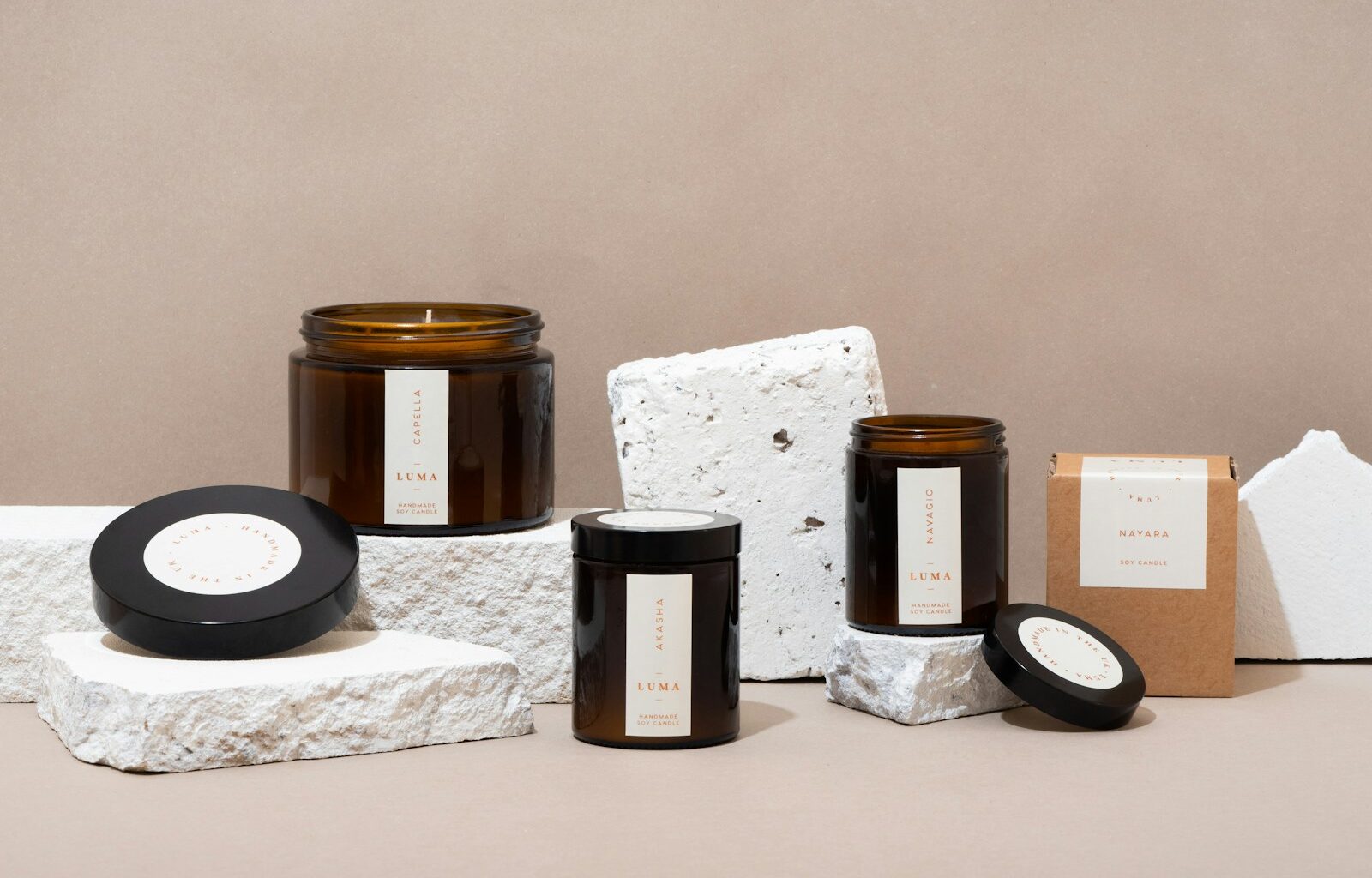Making eco-friendly candles at home eliminates toxic chemicals found in commercial candles while creating customized scents and styles for 60% less cost than store-bought alternatives. Environmental studies show that petroleum-based paraffin candles release 11 known toxins when burned, while natural soy and beeswax candles improve indoor air quality and burn 50% longer than conventional candles.
1. Understanding Eco-Friendly Wax Options
1.1 Soy Wax Benefits and Performance
Soy wax burns cleanly without releasing toxins, produces minimal soot, and holds fragrance exceptionally well while supporting sustainable agriculture. This renewable resource costs less than beeswax while providing excellent scent throw and smooth, even burning characteristics.
1.2 Beeswax Properties and Natural Benefits
Beeswax naturally purifies air by releasing negative ions that neutralize pollutants, allergens, and odors while burning with a warm, honey-like fragrance. This natural wax burns longer than any alternative while supporting bee populations and sustainable beekeeping practices.
1.3 Coconut Wax Advantages and Sustainability
Coconut wax provides excellent scent throw, clean burning, and renewable sourcing while blending well with other natural waxes. This premium option burns cooler and longer while supporting tropical agriculture and providing superior fragrance performance.
1.4 Wax Blending and Custom Formulations
Combining different natural waxes creates custom formulations that optimize specific qualities—soy for affordability, beeswax for air purification, coconut for scent throw. Blending allows fine-tuning of burn characteristics and performance for different applications.
2. Essential Equipment and Materials
2.1 Basic Tools and Safety Equipment
Candle making requires a double boiler, thermometer, wooden stirring sticks, and heat-resistant containers—most available in kitchen supply stores for under $30. Safety equipment includes aprons, heat-resistant gloves, and good ventilation for safe wax handling.
2.2 Wick Selection and Sizing
Cotton wicks provide clean burning and proper flame size when matched correctly to container diameter—too small creates tunneling, too large causes smoking and soot. Wood wicks create crackling sounds and wide flame pools but require different sizing considerations.
2.3 Container Options and Considerations
Glass containers provide heat resistance and reusability while mason jars, teacups, or vintage finds create unique, personalized candles. Ensure containers can withstand heat and have adequate thickness to prevent cracking during burning.
2.4 Natural Fragrance and Color Options
Essential oils provide natural fragrance without synthetic chemicals, while natural colorants like dried herbs, spices, or mica powder create beautiful effects. These natural options cost more initially but provide superior health benefits and environmental safety.
3. Step-by-Step Candle Making Process
3.1 Preparation and Workspace Setup
Set up a dedicated workspace with good ventilation, level surfaces, and easy cleanup options. Gather all materials before beginning and protect surfaces with newspaper or parchment paper to simplify cleanup and ensure smooth workflow.
3.2 Melting and Temperature Control
Heat wax slowly in double boiler to manufacturer’s recommended temperature—typically 170-185°F for soy wax. Proper temperature control ensures good fragrance binding and prevents wax from overheating, which can cause discoloration and poor performance.
3.3 Wick Preparation and Positioning
Secure wicks in container centers using wick stickers or hot glue, ensuring they remain straight and centered during pouring. Proper wick positioning prevents uneven burning and ensures optimal performance throughout candle life.
3.4 Pouring Technique and Cooling Process
Pour wax slowly at correct temperature to prevent air bubbles and ensure smooth surfaces. Allow candles to cool gradually at room temperature for 24-48 hours before trimming wicks and testing burn performance.
4. Natural Fragrance Blending and Aromatherapy
4.1 Essential Oil Selection and Properties
Choose high-quality essential oils that provide desired therapeutic effects—lavender for relaxation, peppermint for energy, eucalyptus for respiratory support. Quality oils ensure better scent throw and longer-lasting fragrance compared to synthetic alternatives.
4.2 Scent Blending and Harmony
Create custom fragrances by blending complementary oils in small test batches before making full candles. Use 6-10% fragrance load for optimal scent throw without overwhelming the space or causing headaches.
4.3 Seasonal and Mood-Based Formulations
Develop signature scents for different seasons and moods—citrus for summer energy, spice blends for winter comfort, floral combinations for spring renewal. Custom formulations create unique candles that enhance specific atmospheres and experiences.
4.4 Therapeutic Benefits and Wellness Applications
Incorporate aromatherapy principles to create candles that support specific wellness goals—stress relief, focus enhancement, sleep promotion, or mood elevation. Understanding essential oil properties maximizes the therapeutic potential of homemade candles.
5. Creative Design and Customization Options
5.1 Layered and Marbled Effects
Create visual interest through colored wax layers or marbled effects that add artistic appeal without synthetic dyes. Natural colorants like turmeric, paprika, or spirulina create beautiful colors while maintaining eco-friendly formulations.
5.2 Botanical Inclusions and Natural Decorations
Add dried flowers, herbs, or botanicals for visual appeal and additional fragrance—lavender buds, rose petals, or citrus peels create beautiful, natural decorative elements. Ensure additions won’t interfere with proper burning or create safety hazards.
5.3 Container Creativity and Repurposing
Use vintage teacups, mason jars, coconut shells, or repurposed containers to create unique, personalized candles. Creative containers add character while supporting zero-waste principles and creating conversation pieces.
5.4 Gift Presentation and Packaging
Design eco-friendly packaging using recycled materials, natural fabrics, or plantable paper that maintains environmental values while creating attractive gift presentations. Sustainable packaging extends environmental benefits throughout the product lifecycle.
6. Quality Control and Performance Testing
6.1 Burn Testing and Safety Evaluation
Test each candle formulation for proper burning characteristics—even wax pool, appropriate flame size, minimal soot production. Proper testing ensures safety and performance before giving candles as gifts or using regularly.
6.2 Scent Throw and Longevity Assessment
Evaluate hot throw (scent while burning) and cold throw (scent when not lit) to ensure satisfactory fragrance performance. Quality candles should provide pleasant scent without being overwhelming or causing respiratory irritation.
6.3 Troubleshooting Common Problems
Address issues like tunneling, smoking, poor scent throw, or uneven burning through wick size adjustments, wax blend modifications, or temperature control improvements. Understanding problem causes enables consistent quality improvement.
6.4 Storage and Preservation Methods
Store finished candles in cool, dry places away from direct sunlight to preserve color and fragrance. Proper storage maintains candle quality and prevents common problems like frosting or scent degradation over time.
7. Advanced Techniques and Business Considerations
7.1 Professional Finishing and Labels
Create professional-looking candles through careful finishing, quality labels, and consistent branding. Attention to presentation details transforms hobby projects into gift-worthy or sellable products that reflect craftsmanship and care.
7.2 Cost Analysis and Pricing Strategies
Calculate material costs, time investment, and desired profit margins to price handmade candles appropriately for gifts or sales. Understanding true costs ensures sustainable hobby practices and realistic business expectations if selling products.
7.3 Safety Regulations and Legal Considerations
Research local regulations regarding candle sales, labeling requirements, and safety standards if considering commercial production. Understanding legal requirements protects against liability while ensuring customer safety and satisfaction.
7.4 Community and Learning Resources
Connect with other candle makers through online forums, local workshops, or craft groups to share knowledge, troubleshoot problems, and discover new techniques. Community involvement enhances skills while providing ongoing support and inspiration.
Conclusion
Making eco-friendly candles provides creative satisfaction, environmental benefits, and significant cost savings while creating personalized home fragrance solutions. The process requires basic equipment and materials but offers unlimited creativity through scent blending, container selection, and decorative techniques. Start with simple soy wax candles using essential oils and basic containers, then experiment with advanced techniques as skills develop. Quality natural materials ensure clean burning and therapeutic benefits while supporting environmental values and personal health. Your homemade candles will provide safer, more personalized alternatives to commercial products while developing valuable skills and creative expression that can be shared with family and friends.












